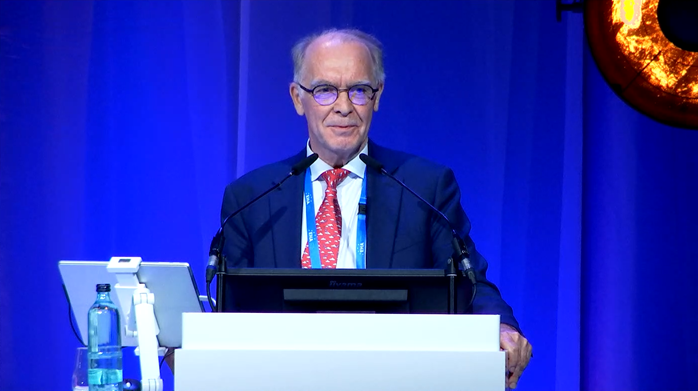Quadruplet regimen shows PFS benefit in transplant-ineligible patients with NDMM




 Dr Thierry Facon
Dr Thierry FaconAdding isatuximab to bortezomib, lenalidomide, and dexamethasone (VRd) regimen provides a significant progression-free survival (PFS) benefit in patients with newly diagnosed multiple myeloma (NDMM) who were ineligible to undergo transplantation compared with VRd alone, according to a prespecified interim analysis of the phase III IMROZ trial presented at EHA 2024.
“The study met its primary endpoint of PFS,” said lead author Dr Thierry Facon from the Department of Haematology, University of Lille, and French Academy of Medicine, Paris, France.
Over a median follow-up of 5 years, the median PFS was not reached in the isatuximab-VRd arm compared with 54.34 months in the VRd arm (hazard ratio [HR], 0.596; log-rank p=0.0005). This translated to a 40-percent reduction in the risk of progression or death. [EHA 2024, abstract S100]
Moreover, a higher 5-year PFS rate was observed among patients who received isatuximab-VRd regimen than those on VRd only (63.2 percent vs 45.2 percent).
The PFS benefit with the isatuximab-VRd regimen was also seen across most subgroups, including difficult-to-treat patients with negative prognostic factors, except for those with high cytogenetic risk at baseline, noted Facon.
Key secondary endpoints
Significantly more patients treated with isatuximab-VRd achieved complete response (CR) or better, which was defined as complete response or stringent complete response (74.7 percent vs 64.1 percent; p=0.01), with a very good partial response rate (89.1 percent vs 82.9 percent; p<0.001), compared with those who received VRd only.
Among those with a CR, a significantly higher percentage of patients on isatuximab-VRd vs those on VRd alone achieved minimal residual disease (MRD)-negative status (55.5 percent vs 40.9 percent; p=0.003). In addition, more patients receiving isatuximab-VRd sustained an MRD-negative status for ≥12 months (46.8 percent vs 24.3 percent).
Although overall survival (OS) data were still immature at data cut-off (September 26, 2023), the interim OS analysis revealed a favourable OS trend with isatuximab-VRd than with VRd alone at 5 years (72.3 percent vs 66.3 percent; HR, 0.776).
Safety endpoints
Grade ≥3 treatment-emergent adverse event (TEAE) rate was higher in the isatuximab-VRd vs VRd alone arm (91.6 percent vs 84 percent). According to Facon, this result was primarily due to the difference in treatment exposure between the groups, as the median treatment duration was longer in the combination regimen than in VRd alone (53.2 vs 31.3 months).
Conversely, the isatuximab regimen and VRd alone arms had similar rates of serious (70.7 percent vs 67.4 percent) and any TEAEs leading to treatment discontinuation (22.8 percent vs 26 percent).
Nevertheless, isatuximab-VRd was well tolerated, and the safety profile remained consistent with the known safety profile of each agent, Facon noted.
New standard of care?
The IMROZ trial included 446 patients (median age 72 years) with NDMM who were not eligible for transplantation. The participants were randomized 3:2 to receive isatuximab-VRd* (n=265) or VRd alone (n=181) for four induction cycles (6 weeks per cycle). Subsequently, they received continuous treatment with isatuximab plus Rd or Rd alone, respectively, on a 4-week cycle.
“IMROZ is the first global phase III study of an anti-CD38 monoclonal antibody isatuximab [combined] with standard of care (SoC) VRd regimen in this patient population, demonstrating a significantly reduced risk of progression or death compared with VRd alone, while providing deep and sustained responses,” said Facon.
“The improved efficacy of [the combination regimen comprising] isatuximab and VRd followed by isatuximab-Rd, combined with a consistent safety profile, provides an important treatment option for frontline disease control, establishing isatuximab-VRd as a new SoC for patients aged ≤80 years who have transplant-ineligible NDMM,” he noted.